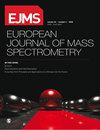Liquid biopsy markers for early diagnosis of brain metastasis patients with breast cancer by metabolomics
IF 0.8
4区 化学
Q4 PHYSICS, ATOMIC, MOLECULAR & CHEMICAL
引用次数: 0
Abstract
Introduction: Breast cancer is the most common cancer in women and is the second most common cause of cancer related mortality. Metabolomics, the identification of small metabolites, is a technique for determining the amount of these metabolites. Objectives: This study aimed to identify markers for the early diagnosis of brain metastasis by metabolomic methods in breast cancer patients. Methods: A total of 88 breast cancer patients with distant metastases were included in the study. The patients were divided into two groups according to their metastasis status: patients with brain metastases and distant metastases without any brain metastases. Liquid chromatography quadrupole time-of-flight mass spectrometry (LC-qTOF-MS) and gas chromatography-mass spectrometry (GC-MS) analysis methods were used for metabolomic analyses. Results: 33 of them, 88 patients had brain metastasis, and 55 patients had distant metastases without brain metastasis. A total of 72 and 35 metabolites were identified by the GC-MS and LC-qTOF-MS analysis, respectively. 47 of them were found to be significantly different in patients with brain metastasis. The pathway analysis, performed with significantly altered metabolites, showed that aminoacyl tRNA biosynthesis, valine, leucine and isoleucine biosynthesis, alanine, aspartate, and glutamate metabolism, arginine biosynthesis, glycine, serine, and threonine metabolism pathways significantly altered in patients with brain metastasis. Predictive accuracies for have identifying the brain metastasis were performed with receiver operating characteristic (ROC) analysis, and the model with fifteen metabolites has 96.9% accuracy. Conclusions: While these results should be supported by prospective studies, these data are promising for early detection of brain metastasis with markers in liquid biopsy samples.代谢组学在乳腺癌脑转移患者早期诊断中的应用
简介:乳腺癌是女性中最常见的癌症,也是导致癌症相关死亡的第二大常见原因。代谢组学是鉴定小代谢物的一种技术,用于确定这些代谢物的数量。目的:本研究旨在通过代谢组学方法确定乳腺癌患者脑转移的早期诊断标志物。方法:对88例乳腺癌远处转移患者进行研究。根据转移情况将患者分为两组:脑转移患者和未发生脑转移的远处转移患者。代谢组学分析采用液相色谱-四极杆飞行时间质谱(LC-qTOF-MS)和气相色谱-质谱(GC-MS)分析方法。结果:其中33例发生脑转移88例,远处转移55例无脑转移。GC-MS和LC-qTOF-MS分别鉴定出72种和35种代谢物。其中47例在脑转移患者中存在显著差异。代谢产物发生显著改变的通路分析显示,脑转移患者的氨酰基tRNA生物合成、缬氨酸、亮氨酸和异亮氨酸生物合成、丙氨酸、天冬氨酸和谷氨酸代谢、精氨酸生物合成、甘氨酸、丝氨酸和苏氨酸代谢途径发生显著改变。采用受试者工作特征(ROC)分析对脑转移的预测准确性进行了验证,其中包含15种代谢物的模型准确率为96.9%。结论:虽然这些结果应该得到前瞻性研究的支持,但这些数据对于用液体活检样本中的标志物早期检测脑转移是有希望的。
本文章由计算机程序翻译,如有差异,请以英文原文为准。
求助全文
约1分钟内获得全文
求助全文
来源期刊
CiteScore
2.40
自引率
7.70%
发文量
16
审稿时长
>12 weeks
期刊介绍:
JMS - European Journal of Mass Spectrometry, is a peer-reviewed journal, devoted to the publication of innovative research in mass spectrometry. Articles in the journal come from proteomics, metabolomics, petroleomics and other areas developing under the umbrella of the “omic revolution”.

 求助内容:
求助内容: 应助结果提醒方式:
应助结果提醒方式:


